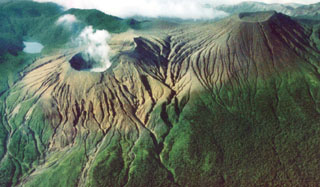Report on Rincon de la Vieja (Costa Rica) — June 1992
Bulletin of the Global Volcanism Network, vol. 17, no. 6 (June 1992)
Managing Editor: Lindsay McClelland.
Rincon de la Vieja (Costa Rica) Continued fumarolic activity
Please cite this report as:
Global Volcanism Program, 1992. Report on Rincon de la Vieja (Costa Rica) (McClelland, L., ed.). Bulletin of the Global Volcanism Network, 17:6. Smithsonian Institution. https://doi.org/10.5479/si.GVP.BGVN199206-345020
Rincon de la Vieja
Costa Rica
10.8314°N, 85.3364°W; summit elev. 1729 m
All times are local (unless otherwise noted)
Fumarolic activity continued through June in the active crater, where it had fed a plume more than 100 m high during May fieldwork. Chemical analyses of water collected 13 May showed pH values of less than 3 in two of the three N-flank rivers sampled, and some enhancement in sulfate and chloride concentrations (table 2). A seismographic station 5 km SW of the crater (RIN3) registered seven low-frequency earthquakes in June.
Table 2. Chemistry of water collected 13 May 1992 from three rivers on the N flank of Rincón de la Vieja. Data courtesy of the Univ. de Costa Rica.
| River | pH | Cl- (ppm) | SO4-2 (ppm) |
| Pénjamo | 2.9 | 1.5 | 392 |
| Blanco | 5.8 | 2.1 | 122 |
| Azul | 2.4 | 10.0 | 384 |
Geological Summary. Rincón de la Vieja is a volcanic complex in the Guanacaste Range of NW Costa Rica. Sometimes referred to as the Rincon de la Vieja-Santa María Volcanic Complex, it consists of a slightly arcuate 20-km-long ridge of 12 craters and pyroclastic cones constructed within the 15-km-wide early Pleistocene Guachipelín caldera, whose rim is exposed on the south side. Sometimes known as the "Colossus of Guanacaste," it has an estimated volume of 130 km3 and contains at least nine major eruptive centers. The Santa María cone, the highest peak of the complex, is located on the E side of the ridge and has a lake within the 400-m-diameter crater. A Plinian eruption producing the 0.25 km3 Río Blanca tephra about 3,500 years ago was the last major magmatic eruption. All subsequent eruptions, including numerous reported eruptions possibly dating back to the 16th century, have been from the active crater, near the center of the complex, with an acidic 300-m-diameter lake.
Information Contacts: E. Fernández, J. Barquero, and V. Barboza, OVSICORI; G. Soto, ICE; Mario Fernández, Univ. de Costa Rica.

